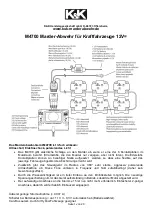
The radiator normally remains completely full, so there is
no need to remove the radiator cap unless checking for
coolant freeze point or replacing coolant. Advise your
service attendant of this. As long as the engine operating
temperature is satisfactory, the coolant bottle need only
be checked once a month.
When additional coolant is needed to maintain the
proper level, it should be added to the coolant bottle. Do
not overfill.
Points to Remember
NOTE:
When the vehicle is stopped after a few miles
(kilometers) of operation, you may observe vapor coming
from the front of the engine compartment. This is nor-
mally a result of moisture from rain, snow, or high
humidity accumulating on the radiator and being vapor-
ized when the thermostat opens, allowing hot coolant to
enter the radiator.
If an examination of your engine compartment shows no
evidence of radiator or hose leaks, the vehicle may be
safely driven. The vapor will soon dissipate.
•
Do not overfill the coolant recovery bottle.
•
Check coolant freeze point in the radiator and in the
coolant recovery bottle. If antifreeze needs to be
added, contents of coolant recovery bottle must also be
protected against freezing.
•
If frequent coolant additions are required, or if the
level in the coolant recovery bottle does not drop when
the engine cools, the cooling system should be pres-
sure tested for leaks.
•
Maintain coolant concentration at 50% HOAT engine
coolant (minimum) and distilled water for proper
corrosion protection of your engine, which contains
aluminum components.
408
MAINTAINING YOUR VEHICLE
Summary of Contents for 300 SRT8 2008
Page 1: ...300 SRT8 O W N E R S M A N U A L 2 0 0 8 ...
Page 4: ......
Page 7: ...INTRODUCTION 5 1 ...
Page 10: ......
Page 80: ......
Page 112: ...110 UNDERSTANDING THE FEATURES OF YOUR VEHICLE ...
Page 113: ...UNDERSTANDING THE FEATURES OF YOUR VEHICLE 111 3 ...
Page 114: ...112 UNDERSTANDING THE FEATURES OF YOUR VEHICLE ...
Page 200: ...PREMIUM INSTRUMENT CLUSTER 198 UNDERSTANDING YOUR INSTRUMENT PANEL ...
Page 289: ...UNDERSTANDING YOUR INSTRUMENT PANEL 287 4 ...
Page 337: ...STARTING AND OPERATING 335 5 ...
Page 370: ......
Page 440: ......
Page 448: ......
Page 459: ...INDEX 10 ...
















































